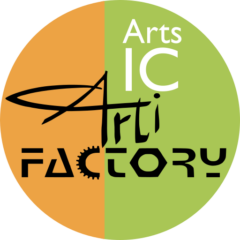Professor Virginia A. Myers and co-inventor of the Iowa Foil Printer machinist Dan Wenman.
Welcome Foilers!
This studio group will give you an introduction to a unique art form invented here, among the cornfields by University of Iowa Professor Emeritus and outstanding printmaker Virginia A Myers and machinist extraordinaire Dan Wenman. Together they found a way to allow individual artists to use the industrial technology of foil stamping to create amazing, iridescent, reflective, subtly colored artworks that stand alone or enhance artworks in other media. We look forward to meeting you and sharing an amazing, beautiful, extraordinary and unique art form. Here is a quickie explanation of what we will be doing in the Foiling Studio Group.
In this video Deanne Wortman will introduce the legacy of Professor Myers and give a the short history of the invention of the art form. Samples of foiled works of art will give you an idea of what the art form has to offer.
An introduction to the Iowa Foil Printer and the basic materials used in hot stamped foiling by Deanne Wortman in this video.
Technique:
This is a chemical bonding as well as a physical process involving polymers, a substrate of prepared paper or other materials, foils, heat, pressure and dwell time (the amount of time under pressure). The heat is provided by a heated hot plate and a hand-held heated roller. The pressure and dwell time are provided by you, the artist! The bonding happens between layers of polymers applied to both the substrate and the polymer incorporated in the foils.
Substrate:
The substrate can be any material that will receive the polymer and can be manipulated on the hot plate and the roller or some other means of applying polymer, pressure and dwell time. The most common substrate is paper but fabric, wood, ceramics, plastics can all be used if they will receive the polymer and heat and pressure can be applied.
Polymers:
Polymers are ubiquitous in nature, are non-toxic, usually dry quickly and are permanent. Acrylic paints, paint mediums and Elmer’s glue are all polymers. Under heat and pressure two surfaces coated in polymers will bond creating a new complex molecule and cannot be separated. This is what happens when we create art using Hot Stamped Foils!
Foils:
The foils we use come in hundreds of colors and transparencies, allowing us an almost unlimited pallet of colors, and visual effects. In industry foil is used on book covers, packaging, for security, etc. They are an amazing 5 layers thick, including a layer each of polymer, wax, pigment, powdered aluminum and a clear plastic carrying sheet. Under heat and pressure the polymer surfaces bond and the wax melts, allowing the pigment and powdered metallic layers to be incorporated into the polymer layer. When it all cools the plastic carrier layer is pulled away, leaving the colored foil on the substrate, your artwork!
Deanne Wortman
PS . . . please bring the following:
- Curiosity
- Small blade frisket (X-acto) knife
- Scissors
- Ruler (straight edge)
- Soft lead pencil, ink pen, erasers
(Optional)
- Laser print (Xerox) images of a high contrast black and white photo
- Acrylic paints, acrylic mediums, and brushes
- Folder or portfolio to store artworks


